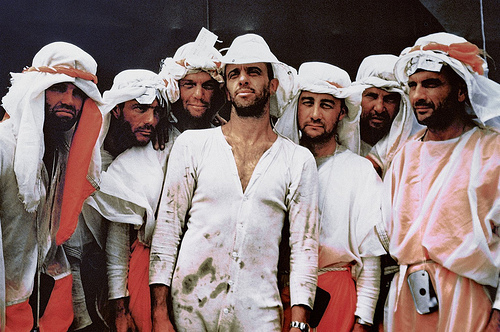Carl Zimmer's Blog, page 71
February 12, 2011
NASA on Flickr: Your afternoon is now officially shot
NASA has selected some great pictures for Flickr. Here's the caption for the image above, "The Original Seven":
In this 1960 photograph, the seven original Mercury astronauts participate in U.S. Air Force survival training exercises at Stead Air Force Base in Nevada. Pictured from left to right are: L. Gordon Cooper, M. Scott Carpenter, John Glenn, Alan Shepard, Virgil I. Grissom, Walter Schirra and Donald K. Slayton. Portions of their clothing have been fashioned from parachute material, and all have grown beards from their time in the wilderness. The purpose of this training was to prepare astronauts in the event of an emergency or faulty landing in a remote area. Forty-five years ago today on May 24, 1962, Scott Carpenter went on to fly the second American manned orbital flight. He piloted his Aurora 7 spacecraft through three revolutions of the Earth, reaching a maximum altitude of 164 miles. The spacecraft landed in the Atlantic Ocean about 1,000 miles, about 1,609 kilometers, southeast of Cape Canaveral after the 4 hour, ...
February 10, 2011
The Panic Virus infects New Haven: Seth Mnookin at Yale, 2/17
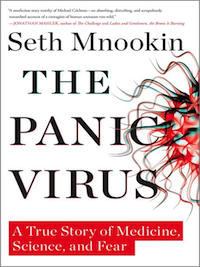 Seth Mnookin has written an important book chronicling one of the most tragic blasts of anti-science in memory: the fraud that was the autism-vaccine link. I asked Seth to come to Yale to talk about The Panic Virus, and he'll be there on Thursday, February 17.
Seth Mnookin has written an important book chronicling one of the most tragic blasts of anti-science in memory: the fraud that was the autism-vaccine link. I asked Seth to come to Yale to talk about The Panic Virus, and he'll be there on Thursday, February 17.
Here are the details:
February 17, 4 pm
Morse College Master's Tea
Morse College Master's House, 304 York Street, New Haven

The Open Notebook peers into one my articles
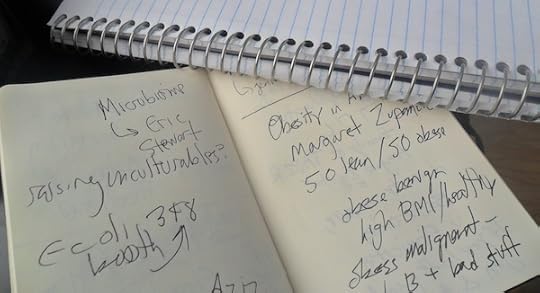 Siri Carpenter and Jeanne Erdmann have started a cool project called The Open Notebook, in which they talk to science writers about how they put together a particular story. For their latest dissection, they chose my New York Times story from last year on the microbes that swarm in our bodies. They talked to me about how I wrote that piece, and my approach to writing in general (short answer: chaos). They even included an audio excerpt from one of the interviews I did for the story. If you're curious about the sausage around here gets made, check it out.
Siri Carpenter and Jeanne Erdmann have started a cool project called The Open Notebook, in which they talk to science writers about how they put together a particular story. For their latest dissection, they chose my New York Times story from last year on the microbes that swarm in our bodies. They talked to me about how I wrote that piece, and my approach to writing in general (short answer: chaos). They even included an audio excerpt from one of the interviews I did for the story. If you're curious about the sausage around here gets made, check it out.
[Image: My microbiome Moleskin]
February 9, 2011
The flea's mighty jump
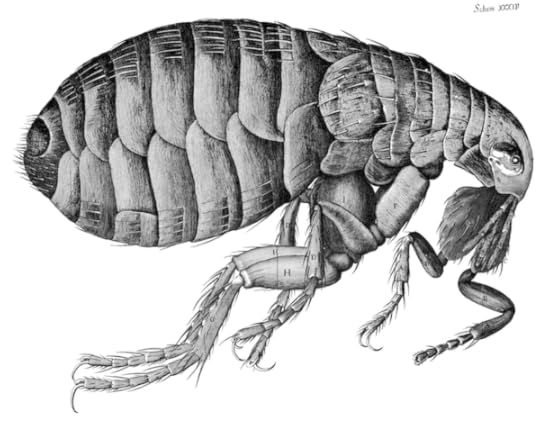 If you could jump like a flea, you'd be traveling 3,000 miles an hour within a thousandth of a second. You can't do it, so how do they manage? That's the 350-year-old question I consider in an article in The New York Times. Check it out.
If you could jump like a flea, you'd be traveling 3,000 miles an hour within a thousandth of a second. You can't do it, so how do they manage? That's the 350-year-old question I consider in an article in The New York Times. Check it out.

February 7, 2011
Lost in Face Space: My latest Discover column
I take a look at the science of facial recognition, and the puzzling ways it fails, in my column in the January-February issue:
Imagine that an eccentric psychologist accosts you. In his hand is a piece of paper with 20 pictures of roses. One of the pictures shows a rose in the flower bed you just passed, he says, and he asks you to pick its picture out from his lineup. The challenge would seem absurd—but if you were to change the roses to faces, nearly everyone could meet it.

February 3, 2011
Darwin Day: See you in Stony Brook!
Darwin turns 102 202 next weekend, and I'll be celebrating by giving the Provost's Lecture at Stony Brook University out on Long Island on Friday, February 11. It's a fitting place to do so, seeing as it's where so many evolutionary biologists are based–not to mention the fact that it was where the great George Williams worked until passing away last year. In my lecture I'll be talking about the ways Williams transformed Darwin's legacy in so many ways–by asking deceptively simple questions such as why we have sex and why we get sick.
Here are the details:
When: Friday, February 11, 7:30 pm
Where: Student Activities Center Auditorium, Stony Brook University, Stony Brook, NY (pdf map of campus)
More information here.
January 31, 2011
Nabokov 2.0: Expanded story, plus reactions
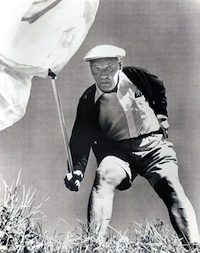 Last Tuesday evening, my article on Nabokov and butterflies went live on the New York Times web site. My editor and I decided on that timing to coincide with the lifting of the embargo on a new paper providing genetic support to a hypothesis Nabokov had about butterfly evolution. But that left a few days before it would appear in print in tomorrow's Science Times. So my editor provided me the opportunity to add to the piece in the intervening time.
Last Tuesday evening, my article on Nabokov and butterflies went live on the New York Times web site. My editor and I decided on that timing to coincide with the lifting of the embargo on a new paper providing genetic support to a hypothesis Nabokov had about butterfly evolution. But that left a few days before it would appear in print in tomorrow's Science Times. So my editor provided me the opportunity to add to the piece in the intervening time.
I rarely get two bites at the journalistic apple, so this was a welcome surprise. I beefed up my account of Nabokov's lepidopteran revival, which started with the work of Kurt Johnson and others–which Johnson recounts in Nabokov's Blues: The Scientific Odyssey of a Literary Genius. (Johnson is a co-author on the new study, too.)
And I also added a section about an amazing coincidence: another group of scientists recently published a molecular study backing another hypothesis of Nabokov's–that Karner's Blue Butterfly is a separate species. The man knew his butterflies.
If you don't get the Times in print, you can read the version 2.0 online now. The print story is accompanied by ...
January 28, 2011
The 4% Universe: My Washington Post review
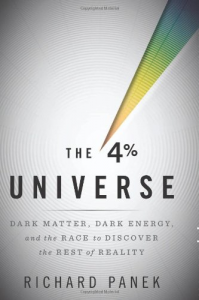 The Washington Post asked me to review The 4 Percent Universe: Dark Matter, Dark Energy, and the Race to Discover the Rest of Reality. Back in my green days as a science writer and editor, I kept up fairly well with things cosmological, but the seductions of biology have distracted me from the sky for some time now. So it was a pleasure to get back up to speed–and to discover just how weird things have gotten in the universe–with Panek's book:
The Washington Post asked me to review The 4 Percent Universe: Dark Matter, Dark Energy, and the Race to Discover the Rest of Reality. Back in my green days as a science writer and editor, I kept up fairly well with things cosmological, but the seductions of biology have distracted me from the sky for some time now. So it was a pleasure to get back up to speed–and to discover just how weird things have gotten in the universe–with Panek's book:
In 1969, an astronomer named Jeremiah Ostriker realized that the Milky Way was spinning too fast. That may sound odd, given that it takes the sun 230 million years to make a full orbit. But when Ostriker tried to simulate the Milky Way on a computer, he found that it was spinning so quickly that it should have ripped itself apart long ago. There weren't enough stars to hold it together.
Ostriker went to his fellow Princeton scientist James Peebles to share his puzzle. "There's something wrong here," Ostriker said to Peebles. The two scientists decided there could only be one solution: The stars we ...
January 26, 2011
WNYC smile segment is online
That was fast–I was just on the Brian Lehrer Show on WNYC to talk about smiles, and they've already posted the conversation on their site. You can listen to it there, or right here:
(function(){var s=function(){__flash__removeCallback=function(i,n){if(i)i[n]=null;};window.setTimeout(s,10);};s();})();
A few minutes in, we talk about a mashup of Obama smiling in White House photos that's been floating around (see below). When I pointed it out to Paula Niedenthal, my main source for my Times article, she likened his smile to the way we say hello on the phone. It always sounds the same, but that sameness doesn't say much of anything about our emotional state.

January 25, 2011
Vladimir Nabokov, evolutionary biologist extraordinaire
 Here's a paraphrasing of an email I got this morning from Harvard biologist Naomi Pierce:
Here's a paraphrasing of an email I got this morning from Harvard biologist Naomi Pierce:
"I don't know if you remember, but I mentioned a few years ago how Vladimir Nabokov, best known as a novelist, was also a self-taught expert on butterflies. In 1945 he had a wild idea about how his favorite group of butterflies evolved that no one took seriously. Well, for the past decade I and my colleagues have been scouring the Andes for butterflies and sequencing their DNA to test his hypothesis. And he turns out to have been right in all sorts of ways.
"Oh, and the paper will be published tonight."
I got on the phone fast. And here's my story on Nabokov's last laugh in the New York Times.


